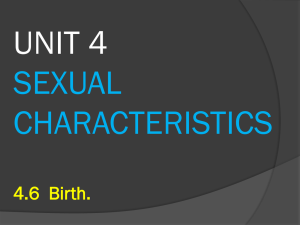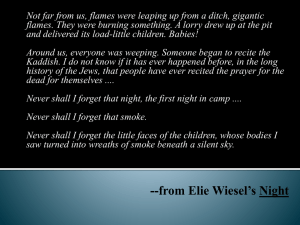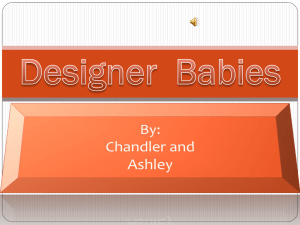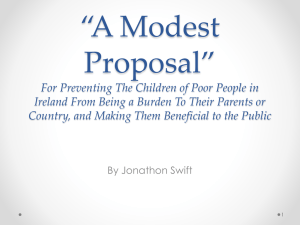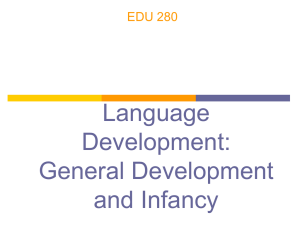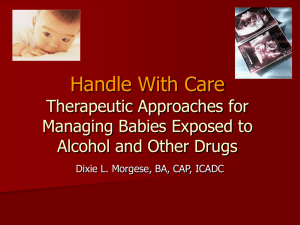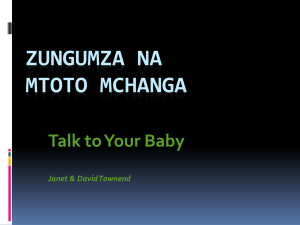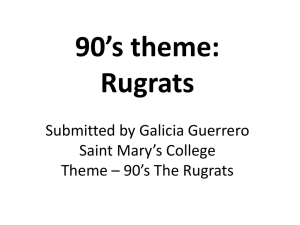INFANT COMMUNICATION
advertisement
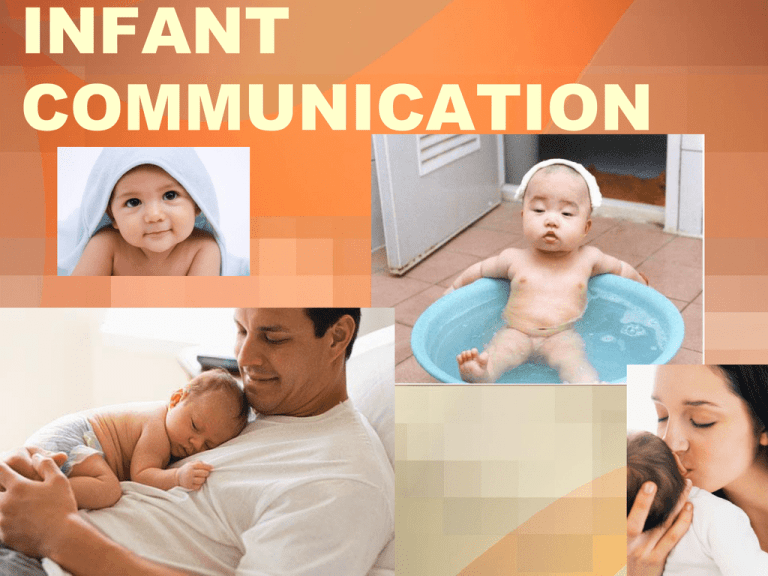
INFANT COMMUNICATION I. DEVELOPMENT IN RELATED DOMAINS** •***For the exam: Infant development milestones in McLaughlin pp. 175-177— lecture notes only will be on exam A. Cognitive Developments Cognitive developments (contd.) B. Social Developments C. Motor Developments By one year of age… II. GENERAL PRECURSORS TO LANGUAGE DEVELOPMENT** •Ability to engage in reciprocal interactions, routines, and general exchanges with others •Ability to recognize and attend to environmental change •Awareness that she can be an agent of change in her own environment As an example of reciprocal interactions… • Talking twin boys official video #2 Harrison, L.J., & McLeod, S. (2010). Risk and protective factors associated with speech and language impairment… Journal of Speech, Language, and Hearing Research, 53, 508-529. III. DEVELOPMENTAL MILESTONES OF INFANT SPEECH** •(TEST 1: please know chart at the top of page 182) •A. Birth-4 weeks: Vegetative sounds like burps, cries •B. 1-4 months: Cooing—vowels that sound like /u/--often accompanied by /k/ and /g/-type sounds (velars). Cooing usually happens in pleasurable face-face interactions with caregivers During babbling…** •The most common sounds are the front and middle sounds •By 1 year of age, most American babies use: /h, d, b, m, t, g, w, n, k/ • **E. 8-12 months—echolalia (not like in autism) This is the baby’s relatively immediate reproduction of speech heard in the immediate environment • F. 9-12 months—jargon. This consists of strings of syllables produced with stress and intonation that sound like real speech. Youtube example of jargon • Baby Talk bla bla bla For test one, do not worry about:** • McLaughlin pages 186 (where it begins Babbling: Discontinuity vs. Continuity) to the bottom of page 188) • I am not interested in this section; it won’t be asked. IV. INFANT AND CAREGIVER COMMUNICATION: RESEARCH DESIGNS** • In longitudinal research, observe same babies over extended period of time • In cross-sectional research, simultaneously observe groups of babies who are different ages • For example, in October, 2012, they might observe ten 8-month olds, ten 9-month olds, and ten 10-month olds. In single-subject experimental designs: V. PRELINGUISTIC COMMUNICATION** •A. Perlocutionary Stage (0-6 months) •Caregivers infer messages--impose communicative significance on babies’ behaviors such as vocal sounds, cries, and smiles. When babies cry…** • There is stimulation of laryngeal and oral functions • Crying alerts caregivers to the baby’s needs • Babies begin to understand causeeffect relationships—they cry (cause), and there is an effect (someone comes to meet their needs) Paul & Norbury, 2012: There are 2 different kinds of smiles:** • Reflexive smiles result from internal physiological stimuli • They occur primarily during sleep • Social smiles occur in response to another person In terms of gaze patterns… Caregivers establish joint attention with their babies Caregivers’ Communication (Please know the chart at the top of p. 199)** • On p. 198, McLaughlin discusses baby talk/motherese/parentese. I will call it motherese. • Motherese has a number of characteristics: high pitch, more pauses, slower rate, simpler utterances, and others. • Babies seem to prefer motherese. Caregivers also engage babies in turntaking activities: Youtube • Cute Baby Playing Pat A Cake - 8 months old - Londyn Thus, again, in the perlocutionary stage… B. Illocutionary Stage (6-12 months)** •The baby’s behavior is consciously directed toward influencing other people to act on some object (e.g., the baby points at a balloon) Halliday classified communicative functions of this stage:** Personal—the baby expresses a sense of herself and her personal feelings • Regulatory—baby is trying to obtain a particular type of interaction (e.g., being picked up, getting fed, trying to get a toy) Babies also often use** • Phonetically consistent forms • These are not attempts at real words • They are reliably associated with certain situations • For example, when the family dog comes in, the baby may say “eebye” VI. EMERGENT LITERACY** •Babies can be introduced to books! •McLaughlin discusses reading beginning at 5-6 months of age •I began on day one Books for babies should… VII. CULTURAL AND SOCIOECONOMIC DIFFERENCES** Caregivers from different cultures interact with infants in a variety of ways. For example: To gain their babies’ attention… In some cultures… In terms of socioeconomic status…

